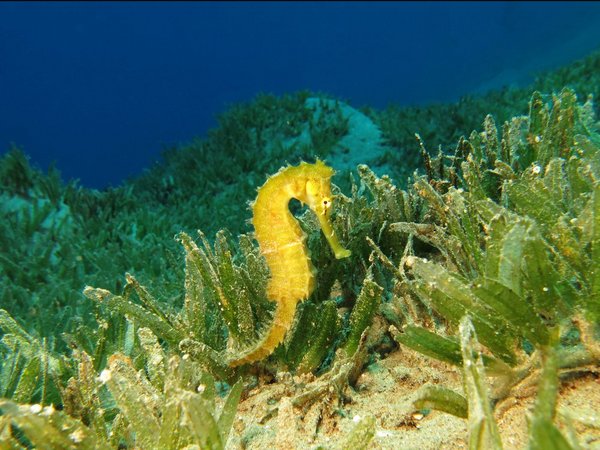- Share this article
- Subscribe to our newsletter
Protection of seagrasses key to building resilience to climate change, says UNEP
Seagrass meadows are among the most common coastal habitats on Earth, covering more than 300,000 square kilometres in at least 159 countries. They nurture fish populations, weaken storm surges, and provide numerous other services to coastal communities. Seagrass ecosystems are biologically rich and highly productive, forming valuable nursery habitats for more than 20 per cent of the world’s largest 25 fisheries. They can filter pathogens, bacteria and pollution out of seawater, and are home to endangered and charismatic species such as dugongs, seahorses, and sea turtles.
But an estimated seven per cent of seagrass habitat is being lost world-wide each year, and at least 22 of the world’s 72 seagrass species are in decline, according to a recent report by UNEP: ‘Out of the Blue: The Value of Seagrasses to Environment and to People’. Since the late 19th century, almost 30 per cent of known seagrass area across the globe has been lost. The main threats to seagrass meadows include urban, industrial and agricultural run-off, coastal development, dredging, unregulated fishing and boating activities, and climate change.
Seagrass meadows are efficient carbon sinks
The report, launched on the 8th July, finds that seagrass ecosystems play an outsized role in combatting the climate crisis. Although they cover only 0.1 per cent of the ocean floor, these meadows are highly efficient carbon sinks, storing up to 18 per cent of the world’s oceanic carbon. Countries aiming to do their part under the Paris Agreement can include seagrass protection and restoration in their nationally determined contributions (NDCs) to help reduce the amount of heat-trapping carbon in our atmosphere.
"Maintaining the health of seagrass ecosystems – which provide food and livelihoods to hundreds of millions of people, support rich biodiversity, and constitute one of the planet’s most efficient stores of carbon – is important for healthy marine life and for healthy people around the world," says Susan Gardner, Director of UNEP-Ecosystems Division. "Seagrasses represent powerful nature-based solutions to the climate challenge and sustainable development."
As the global community works to build back better and strengthen economies and societies in the wake of the devastation wrought by the COVID-19 pandemic, preserving and restoring seagrass ecosystems can be a highly effective way to protect food chains and create jobs in industries such as fishing and tourism, the authors of the report suggest.
Seagrass meadows closely tied to well-being of rural communities
The well-being of human communities all around the globe is closely tied to the health of seagrass meadows. In Tanzania, a decline in seagrass was found to have a negative impact on the livelihoods of women who collect invertebrates, such as clams, sea snails and sea urchins, from seagrass meadows.
In the North Atlantic, seagrass provides critical habitat to juvenile Atlantic cod, a major commercial species that is fished by fleets from more than a dozen nations. “Seagrasses are the super ecosystems of our oceans, providing an incredible range of benefits to people around the world. Yet, while their flashier counterparts attract more attention, they remain among the most unheralded aquatic environments on Earth. The Out of the Blue report showcases the many ways that seagrasses help people thrive and sustain the healthy natural environment that we all depend on,” says Dr Maria Potouroglou, seagrass scientist at GRID-Arendal and lead editor of the report.
Despite their importance, new data suggest that seagrasses are among the least protected coastal habitats. Only 26 per cent of recorded seagrass meadows fall within Marine Protected Areas (MPAs) compared with 40 per cent of coral reefs and 43 per cent of mangroves.
(UNEP/wi)
Read more at UNEP website
More information:
GRID-Arendal
The UN Environment Programme World Conservation Monitoring Centre (UNEP-WCMC)





Add a comment
Be the First to Comment